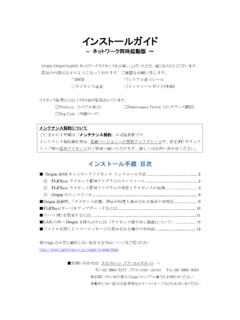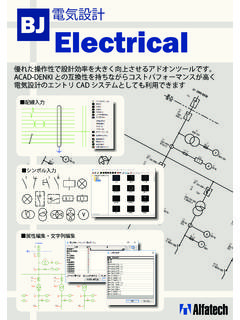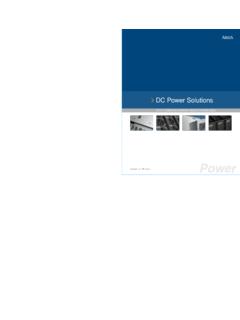Transcription of Cost Estimation for Large Scale Production of Sheet Metal ...
1 University of Erlangen-Nuremberg, Institute for Manufacturing Science ! " " # $#% Fig. 1:Offer Price Range for six Sets of Progressive DiesCost Estimation for Large Scale Production of Sheet Metal Parts Using Artificial Neural Networks*Manfred Geiger; J rgen Knoblach; Frank BackesAbstract:In the field of Sheet Metal working small and medium sized enterprises (SME) are normally supplier companies. They haveto submit valid offers for manufacturing jobs within a short time. The supply price is decisive for getting the manufacturingjob. Therefore, a method of quotation costing has been developed to increase the accuracy of cost planning for Sheet metalparts. A software system is being developed which implements the algorithms of this method starting with the analysis ofthe CAD-model.
2 The manufacturing of Sheet Metal parts in Large Scale Production is mostly done with progressive dies, thecost estimations for such tools are normally based on the plate sequence. To avoid the time and the costs of designing theplate sequence before getting the job, a special calculation method based on Artificial Neural Networks is used for the costestimation of progressive dies. In connection the direct labour costs are calculated by accounting the estimated resourceconsumption for tool manufacturing. Fast and precise pricing is done by the system under consideration of material costs,workcenter costs, overhead costs and pricing : Production Management, cost Estimating, Sheet Metal PartIntroduction*At present in the German mechanical engineering industry 1 % to2 % of the sales volume are spent on writing offers [1].
3 These highexpenses are necessary, because the total Production costs must beestimated accurately at the very moment of placing the offer. Due toan increasing number of offer demands and a decreasing transactionrate the expenses per offer have to be reduced. So, the making of aquotation has to be made cost -effective and thereby more , advantages over competitors can be achieved by anaccelerated to the planning and manufacturing of a product four phasesof calculation are carried out in an enterprise. Quotation costing (1)helps to make an Estimation of the expected manufacturing costsand to set up the offer price. Preliminary costing (2) and & to anincreased extent ' Production attending calculation (3) are used forcost control during manufacturing.
4 Statistical cost accounting (4)reviews the commercial success of an activity after the accuracy of the available cost information rises from quotationcosting to statistical cost accounting. Here, quotation costing isaffected with a high risk, because the binding offer decides over thecommercial success of the future manufacturing order. The manufacturing of Sheet Metal parts in Large Scale Production ismostly done with progressive dies. The design and Production ofthese tools are responsible for an essential part of the manufacturingcosts. Because of the high outputs multiplier an accurate estimationis necessary especially in Large Scale Production . Thereby, a specialestimation method of these tool costs must be considered. At pres-ent, a plate sequence has to be developed for each exact determina-tion of the tool costs, which requires up to four weeks the central economic importance of a binding quotation,many small and medium sized enterprises (SME) practice only arough Estimation for the submission of a tender.
5 This results indeviations of more than 200 % in the field of quotation costing forprogressive dies, without misrepresentation of different enterprisespecific overhead rates. On the other hand only 50 % of the enter-prises stated that they executed this statistical cost accounting onlyoccasionally or never [2]. In such cases no cost control is an inquiry, requests for quotations for six progressive die setswere sent to toolmaker enterprises. The analysis (fig. 1) revealsvariation ranges in the offer prices between %/+ % fortool set #1 and %/+ % for tool set #3. The variations arerelated to each average price calculated from the six offers per from the different cost structures in the individual enterprises,the price differences were caused by the rough cost Estimation .
6 In nocase a plate sequence was developed to determine the exact toolstructure and thus the of the art are calculation sheets for PC-based spreadsheetprograms [3]. These calculation sheets are usually specifically de-signed for the individual enterprise. The input is done manually orvia a menu. Connections to internal Production planning and controlsystems and the use of existing databases are impossible. Besidesthis procedure, there are other methods of calculating Sheet metalparts in which the Estimation of costs is based on a partially auto-mated operations scheduling [4] or performed using MTM-based [5]or consumption-based cost functions [6]. An integrated softwaresystem for offer and job order planning on the base of the hierarchi-cal similarity search was developed in the field of tool and mouldmaking [7].
7 Method of Feature-Based Quotation CostingThe procedure for cost estimating introduced here is based on costfeatures. This procedure was successfully implemented for turned*The authors are grateful for the financial assistance of the Industry ResearchFoundation (Stiftung Industrieforschung), which supports the project workwithin the framework of the research project (Quotation Costing for theManufacturing of Sheet Metal Parts". ) *+ , - . / 0 1 2 - 3 4 3 5 2 3 6 6 , 2 3 5 7 - 8:9 7 ; * <!= > > ) ?Fig. 2:Proceeding of Feature-Oriented Quotation CostingFig. 3: cost Functions Based on the List of FeaturesFig. 4:Neural Networks for cost Estimation of Progressive Diesparts [8]. Input data for the feature-based quotation costing (fig. 2)is extracted from the customer s inquiry.
8 These data includeworkpiece material, quality of the workpiece and required batchsize. The result of the quotation costing is a supply price, in whichthe product costs are calculated and estimated with relation to theselected manufacturing technique and lot size, the date of deliveryand the pricing policy. The determination of the manufacturing costs is performed in threesteps. In the first step the CAD-model is analysed automaticallywith regard to geometric and technical features. For the automaticrecognition of the manufacturing structure of the workpiece, anexisting analysis and classification system for Sheet Metal parts [9]is used. The feature recognition is carried out with analytic geomet-ric analysis, semantic networks and neural networks. The output ofthis system is the base for the quotation costing to be list of recognized features can be completed interactively.
9 Thenext step is to assign the features to possible manufacturing tech-niques. In this step the different features are transformed into tech-nique specific base units. These are machining times, profile lengthsor batch sizes. In the third step the base units are transformed intocosts. At this point the internal costing technique is applied, theinternal key data (workcenter rates, overhead rates, etc.), cost oftools and costs for refinishing, transport, and distribution flow intothe cost Estimation . For the representation of Sheet Metal parts, a specific product modelwith a particular scope in the cost -orientated description of geo-metry- and manufacturing-features was defined and aspects are included in the product model: There are usualdetails such as objects for components, Sheet thickness, expansionof the developed Sheet , information on the material and the exactgeometrical model.
10 On the one hand, special information on bends,features and joining techniques are included. In addition there areitems for information about extra tools (type and number, costs pertool, and medium endurance) and costs for indirect functional areas, the construction department for Production facilities or theoperations determination of the cost -orientated base units (fig. 3) is basedon the list of features of the piece stored in the product model. Inthis list, the possible and internally existing manufacturing technolo-gies are related to the recognized or defined features. All featuresare rated as cost -oriented base units in relation to the possible manu-facturing methods. This means that the cost drivers are derivedaccording to the technology. For example, in the case of profilecutting by nibbling or laser beam cutting the processing time isestimated depending on the profile length, numbers of holes und thegeneral process parameters like the velocity.






